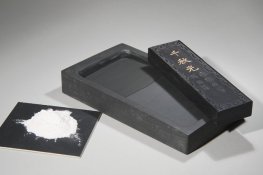Hi,
Freestyle has a nice set of six spot tones that is very reasonably priced and includes a storage box. I suggest the six, because every paper has a different tone, and it also helps to match toners. I have always heard that here is no such thing as a *truly black* dye in existence. All spot tones will have at least a tiny bit of a tint (variations of blue, brown, green, purple, etc.). It especially shows up in spot tone, where you water it down a whole lot to use it.
I would also get a fine-tipped brush. I have never needed anything else. You don't paint the stuff on. I have had the best success placing very tiny, light colored drops on bit by bit (by bit by bit by bit by bit....); simulating grains, building up to the right tone of grey gradually using a light tone, and filling any defects with a lot of tiny spots, rather than filling a defect entirely on one or a few passes. It is like exacting surgery, not painting. It takes forever, but the results are worth it.
Also, be sure to judge your work from a normal viewing distance. The goal is not to perfectly eliminate every defect and perfectly blend every repair so it looks exactly like silver, but just to make them unnoticeable to viewers. If you are judging your work with your eye right up against the print, or under a magnifier, you will be endlessly frustrated and will actually probably end up overdoing it in the quest for seamless perfection.
Additionally, even one drop of the stuff will last you a VERY long time. Get a plastic palette with six little cups from an art store. When you get the spot tone, you can put a drop in each cup; each from a different bottle of spot tone. Let it dry and stow it for later use. Then you don't even need to open the bottles until you have used up all that is there. The set will likely outlive you, me, and everyone else on APUG.
I usually have to mix to get the right tone. Usually I mix neutral (which is actually *quite* blue IMO) with sepia or selenium to match Ilford Warmtone FB glossy or Emaks. Even for Oriental paper, I still need to warm up the "neutral" spot tone.
Yet another thing: Start saving your reject prints for practice, if you don't already. You should always make practice runs on reject prints first, IMO.








 .
.




